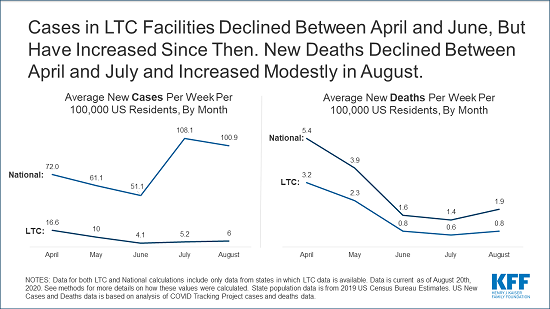
The independent source for health policy research, polling, and news.
COVID-19 Outbreaks in Long-Term Care Facilities Were Most Severe in the Early Months of the Pandemic, but Data Show Cases and Deaths in Such Facilities May Be On the Rise Again
Most States Don’t Report Data for Assisted Living Facilities Specifically, but Those That Do Show Cases and Deaths Rising Over the Summer
The rate of new COVID-19 cases and deaths in long-term care facilities declined markedly in May and June after the novel coronavirus swept through nursing homes in April, but recent data show the incidence may be on the rise again, according to a new KFF analysis.
A second new analysis from KFF examines the impact of COVID-19 on assisted living facilities, a type of long-term care facility that, unlike nursing homes, is not federally regulated, and for which there is a dearth of data about COVID-19 cases and deaths.
The virus has proved particularly deadly among people in long-term care settings, accounting for more than 70,000 deaths of residents and staff as of mid-August, according to the new analysis. People in long-term care facilities make up 8 percent of coronavirus cases, but 45 percent of all COVID-19 deaths.
The new analysis of trends in long-term care facilities finds that coronavirus outbreaks in such settings were most severe in the pandemic’s early stages, particularly in the Northeast, with the number of new cases and deaths in long-term care facilities per 100,000 U.S. residents considerably lower in June and July than in April and May. During August, cases and deaths have been rising somewhat. State-level data show notable state-level variation in new cases and new deaths in long-term care facilities, at most times mirroring patterns of new cases and deaths within the state.
The trend in new cases in long-term care facilities stands in contrast to trends in new cases overall. Nationally, new COVID-19 cases were substantially higher in July and August than in April and May due to the increase in cases among younger people in the summer months. The decline in the rate of new cases and deaths in long-term care settings over time may, in part, reflect measures such as visitor restrictions and more comprehensive testing of residents and staff that were implemented to mitigate the spread of the virus.
Other key findings of the analysis include:
- Nationally, the share of coronavirus deaths associated with long-term care facilities has stayed relatively constant since May, but the share of cases in such facilities has decreased over time. At the beginning of May, nearly 1 of every 5 coronavirus cases were in long-term care facilities. By mid-August, 1 in every 10 cases were. This decline is likely due to broader availability of testing that contributed to the identification of more cases in the general population nationally in June and July, as well as rising cases among younger people.
- Trends in long-term care COVID-19 cases and deaths vary notably across states. Trend lines since April indicate that there are some states, such as New York, Massachusetts, New Jersey, and Connecticut, that have “flattened the curve”, while other states, such as California, Texas, Georgia, and Ohio, have continued to see a rise in long-term care cases and deaths. States that saw early peaks in long-term cases and deaths have experienced the highest burden of cases and deaths in such settings thus far, but that could change as the pandemic progresses.
Cases and Deaths in Assisted Living Facilities
While the impact of COVID in nursing homes has received a fair amount of media attention, assisted living facilities have been largely under the radar, in part because they are not subject to federal reporting requirements. Just 19 states are reporting data for COVID-19 in assisted living facilities separately from nursing homes, finds the other new KFF analysis.
As a result of the inconsistent and incomplete nature of state reporting of COVID data in assisted living facilities, it is difficult to know the true extent to which residents and staff in assisted living facilities have been affected by COVID-19. But based on data from states reporting this information in both June and August, the analysis shows that COVID-19 cases and deaths in assisted living facilities have increased, with a notable increase in cases among staff. This second analysis finds, for example:
- Among the eight states that reported data on COVID-19 cases among staff of assisted living facilities in both June and August, the number of staff cases increased by 156 percent, from 2,085 cases in June to 5,333 in early August.
- In 14 states for which there are data on COVID-19 deaths specific to assisted living facilities, a total of 2,651 COVID-19 deaths among residents and staff of such facilities had been reported as of early August, with a 59% increase in reported deaths among the 10 states reporting in both June and August.
For the full analyses, as well as other data and analyses related to COVID-19 and long-term care, visit kff.org.
